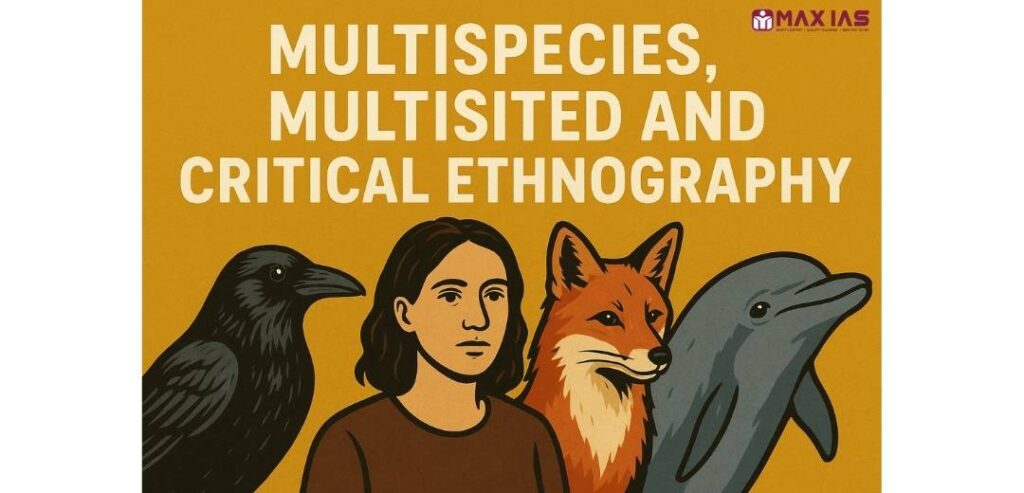
Multispecies ethnography
The relationships between humans and other species have evolved over millions of years, dating back to our ancestors. Human-animal studies, a specialized field within anthropology, challenge anthropocentrism—the notion that humans are the only significant species. This area of study fosters new forms of scholarship that offer alternative perspectives on what it means to be human.
A key approach within human-animal studies is multispecies ethnography, which emphasizes the interactions between humans and various nonhuman species, including plants, animals, fungi, and microbes, within shared environments. Multispecies ethnographies focus particularly on symbiosis, which refers to mutually beneficial relationships between different species.
Researchers in this field adopt a broad, holistic methodology that considers where and how interactions occur between humans and other species. This approach is more complex than traditional ethnography because it requires that the researcher acknowledge both the perspectives of nonhuman actors and their roles in how we see and understand ourselves.
Multi-sited Ethnography
Traditional ethnography, shaped by Malinowski, involved a lone researcher studying a bounded community in one place at a given time.With globalisation, however, this model is challenged. The world is now seen as interconnected, fluid, and mobile, where boundaries and nation-states are increasingly porous. Contemporary theorists stress mobility, flow, and flux, forcing ethnographers to rethink locality, space, and time.
Multi-sited ethnography emerged as a response to globalisation and the limitations of traditional, single-site ethnography. Instead of studying a bounded community in one location, it is mobile and follows links, relationships, and cultural flows across multiple sites, both local and global (Marcus, 1995).
This approach is interdisciplinary, drawing from media studies, feminist theory, cultural studies, and science and technology studies. It pursues objects, ideas, discourses, and people across space and time, recognizing that cultural formations are shaped by interconnections beyond borders.
Example 1 – Nancy Scheper-Hughes (2004): In her study of the global trade in human organs, she “followed the bodies” across Brazil, Argentina, Cuba, Israel, South Africa, and the USA, uncovering continuities between the organ market and historical practices like the Atlantic slave trade.
Example 2 – Julie Laplante (2003): Compared indigenous Brazilian health practices with the humanitarian discourse of Médecins sans Frontières, showing how local and global medical systems intersect.
Example 3 – Sheba George (2000): Examined migration among Kerala-origin families in the USA and India, tracing how transnational connections shape identity, gender roles, and social status.
Multi-sited ethnography may also be comparative, looking at different sites to highlight contrasts and interrelations, or virtual, following discourses and connections through emails, conferences, or online networks. For instance, Thayer (2000) traced feminist NGO discourses between Brazil and Boston, noting asymmetries in the global flow of ideas.
In sum, multi-sited ethnography:
Moves beyond single locations to trace mobility, networks, and flows.
Explores the interplay of local and global processes.
Adapts to new forms of connectivity in a globalised and digital world.
It thus challenges the notion of ethnography as fixed in one place, instead rethinking locality, culture, and identity as interconnected, mobile, and transnational.
Critical Ethnography
Critical Ethnography begins from the belief that research should not only interpret the world but also contribute to its transformation. Inspired by thinkers such as Karl Marx, it challenges the notion that social scientists should merely describe reality without questioning or changing it.
Critical ethnography seeks to expose hidden agendas, critique power relations, and challenge oppressive assumptions. It recognizes that all representation has consequences and rejects claims of neutrality in social research.
Like conventional ethnography, it relies on iterative-inductive research, sustained engagement with participants in their daily lives, observation, interviews, and the production of rich, written accounts. It respects the complexity of human experience, acknowledges the role of theory, and accepts the ethnographer’s presence as part of the research process .
What distinguishes critical ethnography, however, is its explicitly political and emancipatory stance. It allows researchers to judge between competing worldviews, choosing those that are more just, fair, and truthful. Unlike Frankfurt School critical theory—which critiques capitalist society—critical ethnography more broadly emphasizes the use of knowledge to confront systematic inequalities in access to resources like education, health, wealth, and jobs.
Critical ethnographers go beyond documenting meanings of social actions to uncover the “meanings of meanings,” linking everyday practices to larger structures of power and control.
Drawing on Bourdieu’s notion of symbolic violence, they reveal how ordinary interactions reproduce social hierarchies. Even mundane or unpleasant events, when critically examined, can uncover broader processes of domination, taming, and imposed cultural meanings.In short, critical ethnography is hermeneutic, emancipatory, and political. It uses the strengths of ethnographic methods to dig beneath surface meanings, question the taken-for-granted, and ultimately contribute to social justice and change.


